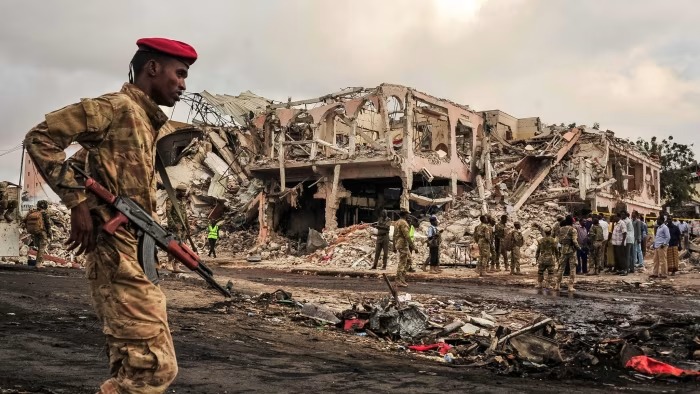Introduction
The recent Somalia Attack in Mogadishu has intensified concerns about security in the Somali capital. Militants from Al-Shabaab targeted a central prison, marking the third major assault this year despite recent gains by Somali authorities. This event highlights vulnerabilities in government facilities, risks to civilians, and ongoing challenges in urban security. International observers continue to monitor the situation closely, emphasizing the importance of proactive security measures and long-term stabilization strategies. Understanding the context and consequences of this Somalia Attack is essential for analyzing the broader security environment in Somalia.
Understanding the Group
Al-Shabaab has engaged in a persistent insurgency in Somalia since the mid-2000s, aiming to undermine the government and enforce strict Islamist rule. Despite territorial setbacks and military pressure, the group retains the capability to conduct high-profile attacks. The recent prison assault illustrates its ability to target symbolic sites and maintain operational strength in the capital.
Recent Security Improvements
Authorities in Mogadishu have strengthened security through enhanced patrols, intelligence operations, and cooperation with international partners. While these measures have improved safety in some areas, the recent prison assault underscores continuing vulnerabilities. The Somalia Attack highlights the ongoing challenges of safeguarding critical infrastructure in densely populated urban areas.
The Prison Assault
The attack focused on Mogadishu’s central prison, a high-risk facility housing militants and political detainees. Such assaults serve multiple strategic purposes: freeing members, intimidating authorities, and undermining public confidence. Eyewitnesses reported heavy gunfire and attempts to breach secure sections. The response by security forces limited casualties, but the event emphasizes weaknesses in urban security systems.
Civilian Impact
The Somalia Attack has serious consequences for the population. Curfews, lockdowns, and interruptions to schools, businesses, and public services affect everyday life. Repeated assaults generate fear and stress among residents, highlighting the need for measures that protect civilians while addressing militant threats.
Government Measures
Following the assault, Somali authorities deployed additional forces, reinforced checkpoints, and coordinated with international allies. Emergency measures aimed to restore order and prevent further attacks. Officials emphasized the importance of community cooperation and proactive measures to minimize risks and maintain stability.
Regional Considerations
The implications of the attack extend beyond Mogadishu. Neighboring countries like Kenya and Ethiopia face potential cross-border threats. Al-Shabaab has a history of regional operations, making coordinated security and intelligence-sharing critical. Regional collaboration is essential to mitigate the broader impact of such incidents.
International Perspective
The international community has condemned the prison assault and reaffirmed support for Somali security forces. Organizations such as the United Nations and African Union provide intelligence, logistical support, and strategic guidance. The attack demonstrates the importance of sustained global engagement to counter extremist threats and stabilize Somalia.
Strategic Objectives
The assault served multiple purposes: freeing imprisoned members, demonstrating capability, intimidating the government, and maintaining visibility. Targeting high-profile sites like prisons reinforces the group’s presence and underscores the challenges authorities face in securing urban infrastructure.
Challenges in Urban Security
The event highlights the difficulties of ensuring safety in densely populated cities. Limited resources, complex infrastructure, and ongoing threats make comprehensive protection challenging. Authorities must balance proactive security with civil liberties while ensuring public safety. Long-term stability requires careful planning, coordination, and international support.
Future Outlook
Addressing the root causes of such attacks is essential. Recommendations include strengthening prison security, enhancing intelligence operations, improving urban infrastructure, and fostering regional cooperation. Political stability and economic development are key factors in reducing extremist influence. Coordinated efforts by Somali authorities and international partners are critical to preventing future attacks and restoring public confidence after the Somalia Attack.
FAQs
Q1: What triggered the Somalia Attack?
Al-Shabaab militants targeted Mogadishu’s central prison to free members and destabilize government authority.
Q2: How often do these attacks occur?
This marked the third major assault on strategic locations in Somalia this year.
Q3: What measures were implemented after the incident?
Authorities reinforced security, deployed additional forces, and coordinated with international partners to prevent further attacks.
Conclusion
The Somalia Attack highlights Al-Shabaab’s persistent threat in Mogadishu despite recent security gains. Repeated assaults reveal vulnerabilities in infrastructure and the ongoing need for counterterrorism efforts. Strengthening governance, urban security, and regional cooperation is essential to mitigate risks. Vigilance, international support, and coordinated measures remain critical for stabilizing Somalia and safeguarding civilians against extremist threats.




